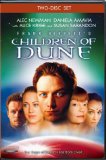Synopsis
The revolution inspired by Paul Atreides has soured, turning into a galaxy-spanning crusadethat is not necessarily liberatory. Intrigue and conspiracy abound as various factions try toundermine Atreides, control him, or destroy him and his children. Combining the two books wasa smart move, since Dune Messiah on its own would be a rather unsatisfactory viewingexperience, and a bit of a downer. Combining the two makes for a much more completenarrative.
Audio< ...p>
The music is very nice, sounding properly expansive, and giving the story a properly epicheft. The environmental effects are okay, but could be much stronger, and this is the kind of filmthat would very much benefit from a sense of being plunged into the midst of an alien world. Thesound is clean and crisp, however, with no distortion of the voices.
Video
A fine transfer, with zero grain, and a nice presentation of the moody, yellowish light thatdominates the scenes on Dune itself. There are no edge enhancement problems that I spotted, andthe picture is very sharp. Flesh tones, blacks, contrasts are all very nice, and the picture is in1.77:1 widescreen. (If Artisan will do this for a TV mini-series, why the fullscreen treatment forso many theatrical films?)
Special Features
Very thin indeed, especially when compared to the loaded package of the first mini-series.There are four storyboard comparisons, and 13-minute look at the visual effects, but that’s it, andI have to say I’m disappointed. The introductory menu is animated and scored, with the mainmenus for the three parts of the story being scored.
Closing Thoughts
If you like the first series, then this should please as well. Though the special effects aren’talways 100% successful (though the sandworms are impressive), the time allowed by the mini-series format really makes it the proper way of addressing this sprawling SF epic.
Special Features List
- Storyboard Comparisons
- “Making Dune’s Children: The VFX Revealed”






